While the Parties of the Paris Agreement submit their new and updated national contributions to tackle the global challenge of climate change, DIE and its partners have begun to update the NDC Explorer as well as expanding the scope of analysis.

With the ratification of the Paris Agreement, Parties to the United Nations Framework Convention on Climate Change (UNFCCC) were invited to communicate new or updated Nationally Determined Contributions (NDCs) with increased ambitions every five years. Despite efforts in the UNFCCC negotiation process to increase transparency, clarity and comparability of NDCs, the documents still vary in terms of structure, content, scope, level of detail, and metrics used.
The NDC Explorer is an online data visualisation that enables users to analyse and compare the content of countries’ (I)NDCs ((Intended) Nationally Determined Contributions). Its consortium consisting of DIE, the African Centre for Technology Studies (ACTS), the Stockholm Environment Institute (SEI) and the Frankfurt School-UNEP Collaborating Centre for Climate & Sustainable Energy Finance (FS-UNEP), now started to update the NDC Explorer with NDCs from the recent update cycle. The update marks the beginning of the third revision of the online data visualisation and its underlying analysis since their initial publication in 2016.
New and updated NDCs: Get some insights
In November, more than twenty existing subcategories of the NDC Explorer have been updated for 82 new and updated NDCs communicated to the UNFCCC until August 2021. Additionally, seven subcategories have been added to the analysis, including subcategories on Article 2.1 and financial policies and regulations. Colleagues from DIE and FS-UNEP have conducted the update and data review.
Some results:
- The success of the Paris Agreement hinges on the ambitions and implementation of NDCs. It is therefore striking to see that the number of NDCs from developing countries that have made their mitigation and adaptation contributions conditional upon international support, seems to have increased in the update cycle from 2015 to 2020s. While this might benefit ambition levels, it could also reduce NDC implementability.
- To understand financing strategies better we have added categories regarding “Government tools on finance” in our analysis of the new and updated NDCs.
- Compared to the data of the First NDCs, the 82 new and updated NDCs communicated until August 2021 show higher results in all analysed climate risks and slow onset processes, besides temperature increase (which most probably is due to a more strict analysis on temperature increase mentioned as climate risk to the Party instead of a general climate risk). This especially applies to floods (67 % mention as a risk compared to 55%), droughts (62% compared to 52%) and sea level rise (49% compared to 39%).
- In the new subcategory “slow onset processes”, we looked at slow onset processes additionally to sea level rise and temperature increase, e.g. loss of biodiversity, desertification or ocean acidification. 35 out of the 82 Parties that communicated their new or updated NDCs until August 2021 mentioned additional slow onset processes.
- Regarding human mobility, around 30 per cent of the Parties mentioned human mobility as a consequence of climate change or an adaptation strategy or both in their new or updated NDC (n = 82); compared to around 17 per cent in the First NDCs ( n= 159)
Analyse and compare the new and updated NDCs in the NDC Explorer: www.NDCexplorer.info
The project team did a careful data analysis, but cannot guarantee that there are no mistakes made. In case you come across any inconsistencies, please contact us.
The data of the updated NDC Explorer remain open access; you can download the data at www.NDCexplorer.info/#open-data
About the NDC Explorer
The NDC Explorer is an online tool to analyse and compare countries’ (Intended) Nationally Determined Contributions (INDCs/NDCs) under the Paris Agreement. It is solely based on information communicated in these documents and pursues the following two aims:
- First, it provides a neutral, sophisticated and user-friendly lens to analyse and compare both qualitative and quantitative (I)NDC content.
- Second, the NDC Explorer stimulates the debate on content, scope as well as formulation and implementation processes of the national climate action plans.
The tool offers information subsumed under five main categories, including climate change mitigation, climate change adaptation, finance and support, and planning processes. Each of these categories provides information and enables comparison on numerous subcategories such as frequently mentioned climate risks, vulnerabilities and priority sectors as well as action to transform the global financial system.
The NDC Explorer is financed by the German Federal Ministry for Economic Cooperation and Development (BMZ) with additional financial contributions by the Swedish International Development Cooperation Agency (SIDA) and the Swedish Research Council Formas.

Schreibe einen Kommentar